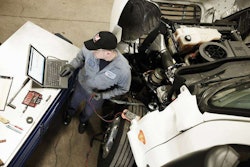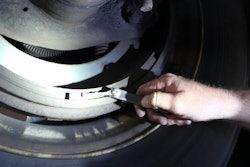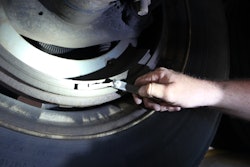It would be great if technicians came standard with a few more sets of hands. Everyone is attempting to answer the industry’s dire technician shortage, but unfortunately, a fruitful solution still seems more mirage than material.
Until technicians saturate repair shops, the best we can do is find the places and tools that can be used to take weight off the shoulders of the overburdened staffs. Oil and coolant analyses are two such programs.
Fluid analysis does double-duty as a preventive maintenance tool and a keystone to the engine or cooling system. With higher underhood temperatures and the accompanying CJ-4 oil formulation in place, monitoring coolant and oil through thorough analysis is more important than ever before. Establish analysis trends and let the tests lend a hand with consistently efficient repairs.
Oil Analysis
Catching potentially catastrophic engine problems before they occur, thus preventing unscheduled downtime, is invaluable to a customer. Oil analysis helps a technician evaluate the level of contaminants present, assess the oil’s condition and establish safe oil drain intervals for customers’ vehicles.
“Basically, oil analysis is a preventive maintenance procedure,” said Dan Arcy, technical marketing manager, Shell Lubricants.
But there are other reasons why a technician should put his customers on a solid oil analysis program. “To start, your customer may have purchased a warranty program from an equipment builder that makes oil analysis part of the warranty requirement,” said Mark Betner, heavy-duty lubricant manager, CITGO Lubricants.
Good oil analysis record keeping makes one defensible in cases of warranty disputes and, according to Betner, can help with equipment resale.
No two engines are alike and oil analysis can help you define the strengths and limitations of each individual piece of equipment. “Oil analysis tells you how a particular machine is doing,” said Shawn Ewing, technical coordinator, commercial lubricants, ConocoPhillips Lubricants, 76 Lubricants brand. “In a nutshell, it gives you the condition of the lubricant and the piece of equipment,” he said.
Since every engine is different, you need to establish individual vehicle trends when implementing an oil analysis program. “For example, an over-the-road Class 8 vehicle and a pick-up-and-delivery truck may both have the exact same engine in them, but their oil analysis may show up differently just because of the type of service they’re under,” Arcy said.
“Trend is the most important word in oil analysis,” said Betner. “Once you have a trend and then, for example the iron levels suddenly bolt, you don’t tear down the engine, necessarily, but instead you take more samples to see if something bad is beginning to happen.”
“A lot of engine manufacturers do have condemning limits on oil contaminants,” said Arcy. “Let’s say that if iron levels rise above 150 ppm that’s a condemning limit. But, if you have an on-highway truck, it only may have iron at 50 ppm, nowhere near the manufacturer’s condemning limit. If you only took a single sample on this vehicle and it came out at 140 ppm, you’d say, ‘hey, it’s okay.’ But there could be something going on if the truck trends at 50 ppm and then suddenly has jumped.”
It’s essential to keep an eye on wear metal trends in oil because an abundance of wear metals not only could indicate premature component wear, but the abrasive particles themselves can generate engine damage. In this case, 140 ppm iron could indicate a rapidly developing problem, but you’d only recognize that through trending.
Aside from wear metals, oil analysis looks for coolant leaks, fuel dilution, soot buildup and can tell you if your customer has high levels of dirt (or silicate) in the engine. All these contaminants have the potential to cause premature engine failure.
Oil analysis also should parse the oil’s condition beyond just identifying contaminants. The oil’s viscosity should be evaluated, as should the total base number (TBN) or total acid number (TAN) of the oil. Either of these two reports can tell you whether or not the oil is capable of protecting the engine against acid corrosion.
“I prefer TAN because it tells you two things about the oil,” said Betner. “It tells you the level of acid building up and it tells you whether or not the oil is breaking down in a condition called oxidation, which causes varnish and sludge.”
When taking oil samples to send in for analysis, technicians should adhere to good sampling practices in order to circumvent false readings. “The key is to get a relative sample,” said Ewing. “What I mean by that is that you need to get warm, flowing oil. The worst mistake is to take a sample at the drain plug when the technician is changing the oil. The technician will crack the drain plug and he’ll get the first few ounces out of the oil to be sampled. That’s absolutely wrong. Don’t get stagnant oil-it will give you a wrong indication about what’s going on.”
Once you have a good sample, make sure you are sending it to a quality oil testing program. When selecting an oil analysis lab, the experts recommend looking for one that offers a comprehensive package and tests across the board. The lab should provide quick results as well.
Choose a lab that provides around-the-clock support for interpreting oil analysis results. Misreading test results happens all too often and can be costly. Your lab should provide clear interpretations of the readings it obtained and keep you abreast of changes in the oil industry. For example, the oil signature for the new CJ-4 oils is different than it was for CI-4 Plus oils. Your oil analysis lab should be aware of the altered chemical footprint and should let you know what resulting changes you can expect.
Consistent, thorough oil analysis from a reputable vendor shows you the current state of your customer’s engine and, through proper reading, gives you a glimpse into its future. Take the necessary time now to implement solid analysis procedures and you will reap the double benefits of time saved and trust earned down the road.
Coolant Analysis
Oil isn’t the only fluid that gives a technician a look into the condition of customers’ vehicles. Coolant also is information rich when analized and it can clue you in to potentially hazardous changes in a vehicle’s functioning before catastrophic failure.
According to Old World Industries, more than 40% of a diesel engine’s downtime is caused by cooling system problems. The main contributors to this statistic are cavitation (or wet sleeve cylinder liner pitting), corrosion, the presence of scale, which seals in heat, and phosphate and silicate dropout. Regular coolant testing examines each of these areas.
Conventional coolant often is a 50/50 mix of antifreeze and water. In order to protect various engine functions, extend coolant life and remove heat, supplemental coolant additives (SCAs) are added to coolant. These additives act as inhibitors against cooling system wear. When coolant comes pre-loaded with additives it is referred to as fully-formulated coolant.
Extended-life coolant (ELC) is a third type of coolant used with diesel engines. This costlier coolant is said to require fewer coolant change-outs and eliminates the use of SCAs, but does require different testing methods.
Unlike oil analysis, which typically is performed in a lab remote to the shop, fully-formulated coolant analysis often is performed by a technician onsite. “In coolant analysis, you’re looking for any kind of premature wear that’s taking place inside the cooling system,” said Arcy. “You also are looking for contaminants. And with ELC, you’re testing to see that you have the necessary additives present to prevent pitting.”
“To test fully-formulated coolant, you use test strips,” said Carmen Ulabarro, coolant marketing specialist, Chevron Lubricants. “Most of the test strips have a couple of pads on them which, when immersed in the coolant, will turn a certain color. The color tells you what’s going on with the inhibitors, the freeze point and even sometimes the pH,” said Ulabarro. “Normally, the pH of the coolant will shift with normal use over the coolant’s service life. Large drops in pH-pH becoming more acidic-can be indicative of blow-by from the combustion process or extremes in the temperature to which the coolant may be exposed.”
If inhibitor levels are incorrect, wet-sleeve cavitation could occur-a serious condition in which the cylinder sleeves erode. If the cylinder sleeve erodes, coolant could get into the piston, causing catastrophic engine failure.
While coolant testing is done conveniently onsite, it is subject to operator error. Using a proper testing method is imperative to coolant maintenance; make sure you adhere to good procedures. “You have to have the right test strip for the coolant you’re using,” said Ulabarro. “Not all fully-formulated coolants are based on the same. If you’re not using the right test strip for the coolant that you are testing, you may obtain results that don’t give you an accurate evaluation of the coolant’s condition.”
Once you determine that you have the right test strips, check the expiration date. Expired strips also can skew results. Next, read the testing instructions and follow them to the letter.
“Test strips must be read according to the instructions. You can’t stick a test strip in a coolant that’s too hot and you can’t stick a test strip in the coolant and just leave it on the counter, then come back ten minutes later and read it because the colors may have changed,” said Ulabarro. Also make sure you aren’t submersing the test strips for a longer than necessary period of time because this can alter the colors displayed.
Although ELC lasts much longer than fully-formulated coolant and cannot be tested with test strips, it’s still important to test this coolant periodically.
ELC has a different chemical composition than other coolants and therefore, mixing of the two coolant classifications leads to trouble. Coolant analysis can tell you if your ELC has been improperly diluted or mixed with another variety, thus rendered ineffective.
Coolant test strips are cheap and easy to use, so there’s no excuse for poor coolant testing practices. Coolant may not often be seen as a technician’s tool, but when tested correctly and consistently, it can become a display case for the inner happenings of the cooling system.
For More Information
For more information on oil and coolant, you may contact the following companies directly or use the FREE Reader Service Card in this issue. Other companies offering information on oil can be found in the Truck Parts & Service Aftermarket Buyers’ Guide & Directory as well as in The Buyers’ Guide on our Internet web site at www.truckpartsandservice.com.
BP Lubricants America
Baltimore, MD
877-LUBES-BP
www.bplubricants.com
Castrol Heavy Duty Lubricants Inc.
Baltimore, MD
800-777-1466
www.castrolhdl.com
Champion Laboratories Inc.
Luber-finer
Albion, IL
800-851-3641
www.luberfiner.com
Chevron Corp.
San Ramon, CA
800-LUBE-TEK
www.chevron.com
CITGO Petroleum Corporation
Tulsa, OK
800-331-4068
www.CITGO.com
ConocoPhillips
Houston, TX
800-255-9556
www.conoco.com
Donaldson Co. Inc.
Engine Systems & Parts
Minneapolis, MN
800-374-1374
www.donaldson-filters.com
ExxonMobil Corp.
Fairfax, VA
800-662-4525
www.exxon.com
www.mobil.com
FPPF Chemical Co.
Buffalo, NY
800-735-3773
www.fppf.com
Freightliner LLC
Alliance Brand Parts
Portland, OR
www.alliancebrandparts.com
Honeywell, Inc.
Prestone
Perrysburg, OH
800-890-2075
Kendall Motor Oil
Houston, TX
800-368-1728
www.kendall.com
Old World Industries
Northbrook, IL
847-559-2000
www.finalcharge.com
Petro-Canada America Lubricants Inc.
Chicago, IL
800-284-4572
www.petro-canadaamerica.com
Shell Lubricants
Houston, TX
800-64-LUBES
www.rotella.com
The Valvoline Company
Ashland Laboratory
Lexington, KY
800-TEAM-VAL
www.valvoline.com
Wix Filtration Products Division
Affinia Group
Gastonia, NC
704-864-6711
www.wixfilters.com











